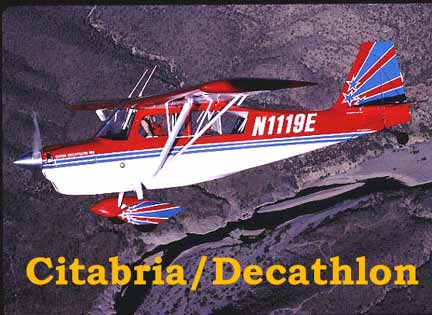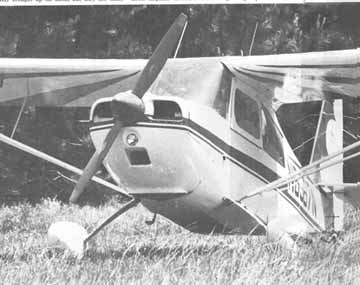
CITABRIA: THE BARGAIN BASEMENT CLOWN
By Budd Davisson, Air Progress. March, 1981
It just doesn't seem possible! There's no way fifteen years (Ed note: now 40 years!!! Even more unbelievable!) could have elapsed since Champion set the sport aviation world on its ear by doing the unthinkable . . . building an aerobatic airplane! But it has been that long and, for better or worse, the "Citabrick" has made its mark on a generation of pilots who discovered aerobatics in this canvas dumptruck of an airplane. It's been called ugly, slow, bulky, heavy on the controls and any number of unkind things, and all of them are correct. But, don't forget; when the Citabria popped out of the womb, aerobatics had been dead nearly twenty years. It was an all but unknown sport. A lot of the aerobatic world owes the Citabria more than a small debt of thanks. It became the Stearman of our generation and, like it or not, it is a measurable part of our heritage.
 |
|
| The spring gear of the Citabria was initially disliked and had some weaknesses. Now we've all acclimated to it's slightly squishy feeling and like the forgiveness it builds into the directional control. |
The Citabria, as the whole world knows, is, or rather was, a rehashed 7AC Champ. In the early 1960s the little Champ was still batting around trying to earn its keep as a trainer, and was doing the excellent job it always had. However, flight operators with tailwheel Champs were trying to swim upstream, the nosewheel had almost completely converted aviation. The Champ lineage would have ended right there, had they not decided on one last desperate attempt at saving her. A few gussets, a little more metal, and they had the Citabria, which is Airbatic spelled backwards which still rates as a classic example of 1960s marginal marketing.
Champion, who had bought the design from the Aeronca company
in the 1950s, then started on a major program that eventually
evolved the Champ/Citabria into a complete product line. The
thing had engines from 100 hp to 180 hp stuffed in it. It's
been festooned with flaps and spray booms, fat tires and long
wings, constant speed props and greenhouse doors. But it was,
and is, still a Champ. With twice the horses of the original,
the bird is only twenty-five to thirty mph faster and with
super aerobatic symmetrical wings and all the hot aerobatic
stuff on it, they couldn't destroy the soul of the Champ. It
still has a very naive, likable flying quality about it that
makes it feel comfortable to a pilot in an amazingly short
number of hours. It's got that "old shoe" feeling.
The original Citabria really was a revamped Champ. The only outward
differences were squared off wing tips and tail surfaces. The
very first ones, even retained the "V" gear of the
Champs and had a 100 hp Continental in the nose. These are
very few and far between these days because Champion almost
immediately changed to a 115 hp Lycoming (7ECA) and junked
the expensive-to-build "V"
gear in favor of a spring steel leaf gear.
Many of the instructors at the time moaned plenty about that spring steel gear. The old gear allowed you to drive down final and plant the mains on with little or no trouble, something that was mighty appreciated when both the wind and the student were crossed up. The spring gear was just that, a spring. It took a lot more technique for a student to master wheel landings. If he dropped it in or tried to force it on from a few inches up, he'd start crow-hopping down the runway like a motorized pogo stick. Everybody learned to live with it, of course, and in all probability, it made better pilots because they had to work harder to make a good wheel landing.
The basic Citabrias only saw a few minor aerodynamic changes
during the span of their production. The elevators were produced
in three flavors, each with an increasing amount of aerodynamic
balance, which went a long way to reducing elevator stick loads.
After Bellanca bought the company and started the Decathlon
series, of course, the wings were completely redesigned. The
Decathlon went to a nearly symmetrical airfoil and sealed ailerons
to give the airplane better inverted performance. Along the
way, the cowling was cleaned up considerably, but the new one
piece construction made it difficult to fully inspect the engine
during preflight.
When it came to problems, the Citabria/Decathlon series certainly
had theirs. It's hard to tell how many of these would have
never shown up if the airplanes hadn't been aerobatted, but
just about all of them have been akroed plenty, at this point
in time. Many of the problems were fixed quickly, but some
lingered on for years and years.
For lots more pilot reports like this one go to PILOT REPORTS